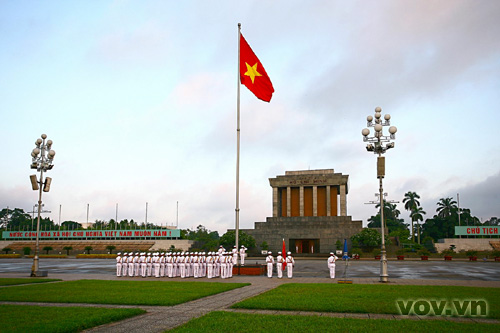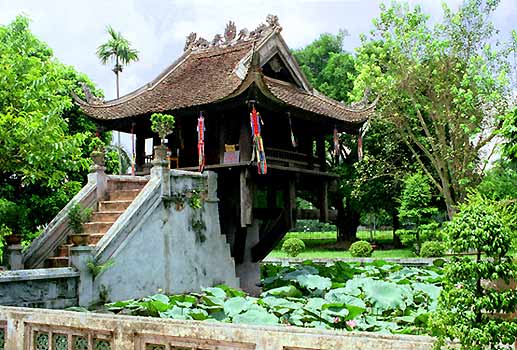The mausoleum is the last resting place of Ho Chi Minh. It is a symbol of gratitude and respect of Vietnamese people for president Ho Chi Minh.
History of Ho Chi Minh Mausoleum
Construction work began on September 2, 1973 and the structure was formally inaugurated on August 29, 1975. The mausoleum was inspired by Lenin's Mausoleum in Moscow but incorporates distinct Vietnamese architectural elements, such as the sloping roof. The exterior is made of gray granite, while the interior is gray, black, and red polished stone. The mausoleum's portico has the words "Chủ tịch Hồ Chí Minh" inscribed across it, meaning "President Ho Chi Minh."

Ho Chi Minh Mausoleum
In his will, Ho Chi Minh stated his wish to be cremated and to have his ashes scattered in the hills of north, central, and southern Vietnam. He said that he preferred cremation because it would be "more hygienic than burial and would also save land for agricultural purposes." The mausoleum was built in spite of his wishes.
Ho Chi Minh Mausoleum
The structure is 21.6 metres high and 41.2 metres wide. Flanking the mausoleum are two platforms with seven steps for parade viewing. The plaza in front of the mausoleum is divided into 240 green squares separated by pathways. The gardens surrounding the mausoleum have nearly 250 different species of plants and flowers, all from different regions of Vietnam.

Ba Dinh square
Ho Chi Minh's body is preserved in the cooled, central hall of the mausoleum, which is protected by a military honour guard. The body lies in a glass case with dim lights. The mausoleum is closed occasionally while work is done to restore and preserve the body but is normally open daily from 9:00 am to noon to the public. Lines of visitors, including visiting foreign dignitaries, pay their respects at the mausoleum.
Around Ho Chi Minh Mausoleum
The grandeur of the mausoleum is a strange contrast to the simple stilt house where Ho Chi Minh lived and worked. Built in the style of ethnic minority dwellings, it overlooks a large carp pond and is a calm sanctuary. Visitors can look through the windows to see the austere furnishings and his few personal possessions. On his desk each day is a vase of his favourite blossoms, hoa hue trang, a sweetly scented flower rather like a tall white bluebell.

Uncle Ho House and fish pond
Nearby is the magnificent Presidential Palace, once the palace of the Governor-General of Indochina during the colonial period. Unfortunately, it’s not open to the public.
In the opposite direction, the Ho Chi Minh Museum provides a comprehensive overview of the man’s life and work and his vision of peace and happiness. It’s informative, but understandably overlooks some of the more risqué episodes in his life. Close by, the famous One Pillar Pagoda is worth a passing look. Although it’s one of the symbols of Hanoi, it’s something of a disappointment as it’s a modern replica.

One pillar pagoda
The Ho Chi Minh Museum is open from 08.00 to 11.00 and from 13.30 to 16.30 daily.
A short walk across Da Dinh Square directly in front of the mausoleum takes you past the Tomb of the Unknown Soldier, a stunningly beautiful monument especially when illuminated at night. From there, another short walk takes you to the Hanoi Citadel.
The mausoleum is the last resting place of Ho Chi Minh. It is a symbol of gratitude and respect of Vietnamese people for president Ho Chi Minh.
If tourists in Vietnam Travel have chance to visit Hanoi, Ho Chi Minh mausoleum is a must-see place that should not be missed!
www.vietnamtourism.org.vn
(84-63) 3 826042 – (84-63) 3 511142
No 54 Nguyen Dinh Chieu, Ham Tien Central Mui Ne Beach Binh Thuan Vietnam
523 To Hien Thanh District 10 Ho Chi Minh City Vietnam
Ha Long Halong City Quang Ninh Vietnam
A13 Hung Thong 2 Halong City Quang Ninh Vietnam




